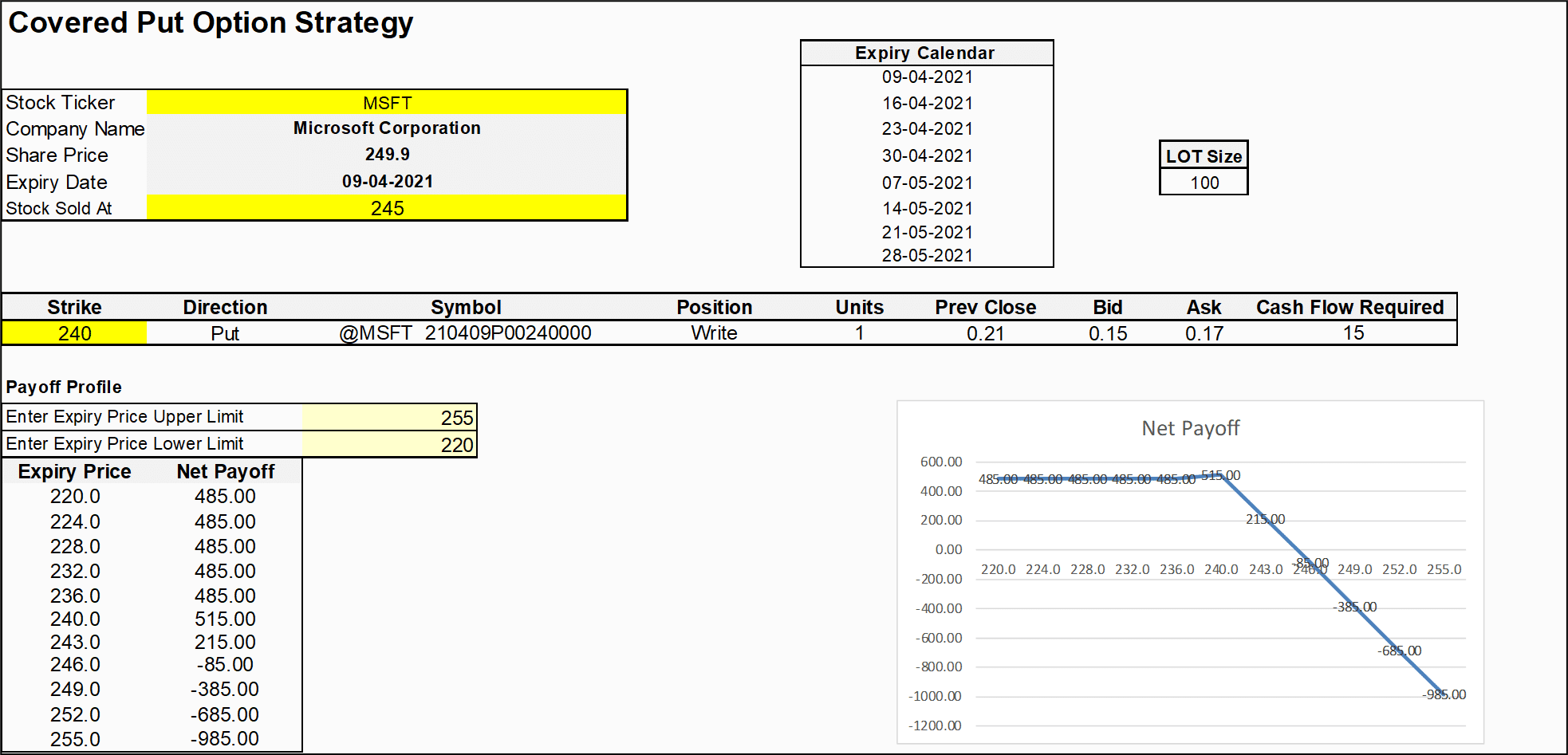Options Trading (Strategies)

Meet The Ultimate Excel Solution for Investors
- Live Streaming Prices Prices in your Excel
- All historical (intraday) data in your Excel
- Real time option greeks and analytics in your Excel
- Leading data in Excel service for Investment Managers, RIAs, Asset Managers, Financial Analysts, and Individual Investors.
- Easy to use with formulas and pre-made sheets

Neophyte and even experienced investors are often wary of options trading. Many people view options as risky, exotic, and only for investors with large bankrolls. However, nothing could be further from the truth. Options are excellent for investors, regardless of experience or risk tolerance, to expand their portfolios and make money in the stock market—whether the market is going up or down.
Options as a strategic investment are the perfect vehicle for increasing your leverage, allowing you to turn a small investment into exponentially large rewards. They can also be used as an insurance policy, protecting your investments in case of a market downturn. In short, options are a tool that every investor should understand and potentially put to use.
Read on to get started in the exciting world of options trading.
What are Options?
Options are financial derivatives that involve a buyer and seller where the buyer pays the premium for an option in return for the rights granted by the contract. Traders buy and sell options for speculation to hold a leveraged position, and Investors usually buy or sell options for hedging purposes to reduce the risk of their overall portfolio.
A stock options contract may be in two forms: call options and put options. In both cases, you have the right, but not the requirement, to either buy or sell the underlying stock for a predetermined price, also known as the strike price.
Options Prices and Valuation
Several factors go into determining the price or premium paid for an options. One of the most important factors is the current price of the underlying security.
It is in constant flux based on market conditions and what the underlying security is doing. The premium is equal to the intrinsic value (the amount the options is in the money) + the time value (the longer the time left until the expiration date, the higher the value). When you sell your options, you must deduct the amount of the premium from your profit.
Based on the current price of the underlying asset, an option is said to be either in-the-money (ITM), at-the-money (ATM), or out-of-the-money (OTM).
Options Trading Strategies
Unlike stocks where strategies are limited, options traders are blessed with flexibility as they can play around with expiry date, premiums, and volatility to forge a strategy of their own.
Here are some of the Options Strategies that can be useful to Traders and Investors.
A covered put is a bearish investment strategy. Applying the covered put strategy is a way to reduce risk.
This strategy involves shorting the underlying asset and selling a put option with the same number of shares. The trader generates income in the form of a premium by writing the put option. This strategy gives a net credit.
The profit is only limited to the amount of premium received on writing the option. The risk is unlimited and may go on increasing as the price of the underlying stock goes on increasing.
To learn more about this strategy, read the detailed article here.
2. Collar Options Strategy
A collar options strategy protects the investor against the risk of losses from a fall in the value of an underlying asset. It combines two varied strategies to limit the loss cap and the gain cap simultaneously involved in an investment. The aim of this strategy is not to produce heavy gains but to provide cover against losses. It summed protective put and covered call strategy to make it’s magic work.
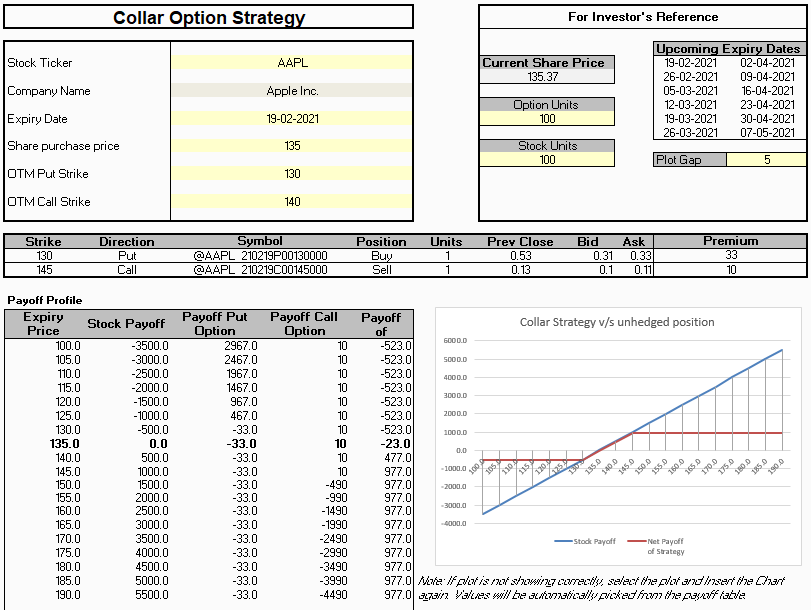 alt="Options Trading (Strategies)">
alt="Options Trading (Strategies)">
Protective Put: The protective put strategy is also known as a synthetic call; it involves managing the underlying risk against an asset by buying an option at a strike price almost near or equal to its current market value. It aims to hold a long position against the asset and provide protection in cases of a decrease in the market value.
Covered call strategy: The covered call strategy provides a cover and the protective put to exercise the collar options strategy. It involves typically selling an OTM (out of the money) call option when the strike price is higher than the market price.
The collar option strategy is created when a long underlying asset is purchased, along with a long OTM put option and a short OTM call option. The investor enjoys profit because of its long position on the underlying asset when its market price increases and vice versa faces loss when the price falls. In the latter case holding the long position on the OTM put option provides cover against the decrease in the asset value and the put option value increases. Hence, it neutralizes the overall impact of the trade. Similarly, when there is an increase in the underlying asset’s value, the investor can experience losses due to his short position on an OTM call position. This potential loss neutralizes the upside of holding the stock.
To learn more about this strategy, read the detailed article here.
3. Short Strangle Options
 alt="Options Trading (Strategies)">
alt="Options Trading (Strategies)">
A Short Strangle Options Strategy involves selling both OTM call, and OTM put options in the same underlying asset with the same expiry date but with different strike prices. The investor needs to sell the OTM Call Option and OTM Put Option under this strategy. This strategy is sound when markets or the asset show less volatility and lie in a specific range.
To learn more about this strategy, read the detailed article here.
4. Bull Put Spread Options Strategy
 alt="Options Trading (Strategies)">
alt="Options Trading (Strategies)">
The options trader uses the bull put spread options strategy when having moderately bullish expectations on the market or stock. Under this strategy, the trader buys and sells the same asset’s put options with the same expiry date but with different strike prices. Also, this strategy involves limited profit and limited risk.
A Bull put spread options strategy consists of one OTM put and one ITM put option. The options trader buys the OTM option with a higher strike price and sells the ITM options with a lower strike price.
The options trader will pay a premium for buying the OTM put option and receive a premium for selling the ITM put option. As the premium received on the selling the ITM put option is higher, the trader is already in profit at the beginning of the trade.
In case of a rise in market price, the trader keeps the net premium received, which is also the maximum profit. Similarly, in case of a fall in market price, the trader’s loss is capped to the difference between the two strike prices minus the put options’ net premium.
To learn more about this strategy, read the detailed article here.
5. Bear Call Spread Options Strategy
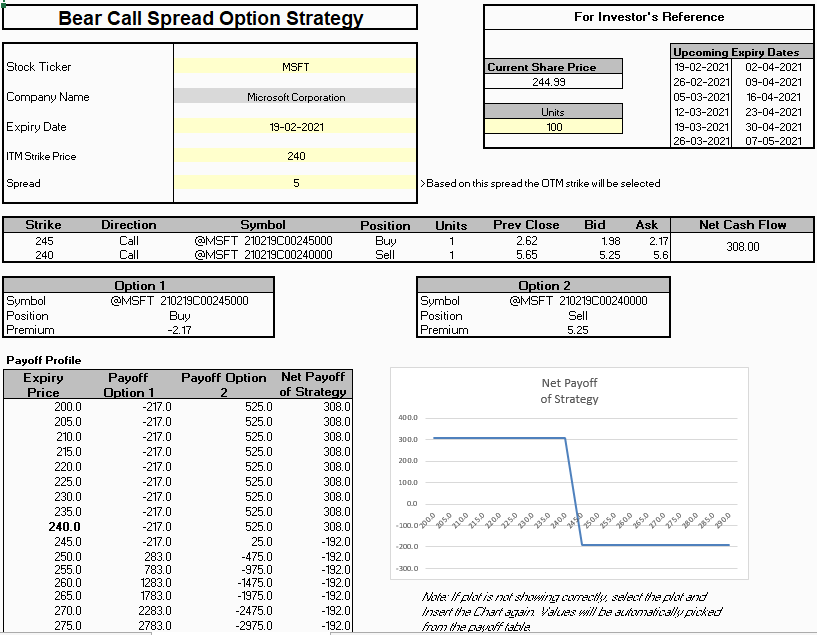 alt="Options Trading (Strategies)">
alt="Options Trading (Strategies)">
The options trader uses the bear call spread options strategy when having moderately bearish expectations on the market or stock. Under this strategy, the trader buys and sells the same asset’s options with the same expiry date but with different strike prices. This strategy involves limited profit and limited risk.
A Bear call spread options strategy consists of one OTM call and one ITM call option. The options trader goes long on the OTM option with a higher strike price and goes short on the ITM options with a lower strike price.
The options trader will pay a premium for buying the OTM call option and receive a premium for selling the ITM call option. As the premium received on the selling the ITM call option is higher, the trader is already in profit at the beginning of the trade.
In case of a rise in market price, the trader’s loss is capped to the difference between the two strike prices minus the call options’ net premium.
Similarly, in case of a fall in market price, the trader keeps the net premium received, which is also the maximum profit.
To learn more about this strategy, read the detailed article here.
6. Long Calendar Spread with Puts
 alt="Options Trading (Strategies)">
alt="Options Trading (Strategies)">
The Calendar Spread with Put options strategy can help us tackle market volatility and gain profits when prices are expected to expire at the strike price at the expiry of the front-month option. This strategy is used to profit from neutral stock price action at the strike price. It also limits the risk in either direction of the strike price. The maximum gain happens when the options expire at the strike price of the puts.
A long calendar spread is also referred to as the ‘time spread.’ While it can be implemented using both puts and calls depending on the nature of the investor to go bearish or bullish, the focus here is going to be on the puts. It involves two major components – selling a short-term put option and buying a long-term put option with the same strike price but with different expiration months simultaneously.
To learn more about this strategy, read the detailed article here.
7. Long Calendar Spread With Calls Option Strategy
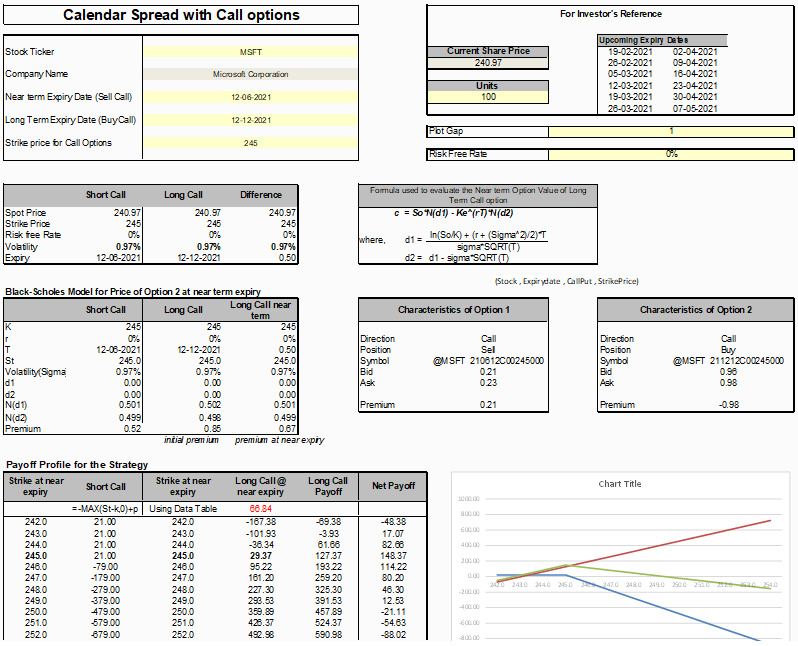 alt="Options Trading (Strategies)">
alt="Options Trading (Strategies)">
A long calendar spread with calls is created by buying one “longer-term” call and selling one “shorter-term” call with the same strike price. The maximum profit is realized if the stock price equals the strike price of the calls on the expiration date of the short call. This is the maximum profit point because the long call has maximum time value when the stock price equals the strike price. Also, since the short call expires worthless when the stock price equals the strike price at expiration, the difference in price between the two calls is at its greatest.
The maximum risk of a long calendar spread with calls is equal to the cost of the spread, including commissions. If the stock price moves sharply away from the strike price, then the difference between the two calls approaches zero, and the total amount paid for the spread is lost.
To learn more about this strategy, read the detailed article here.
8. Long Butterfly With Puts Option Strategy
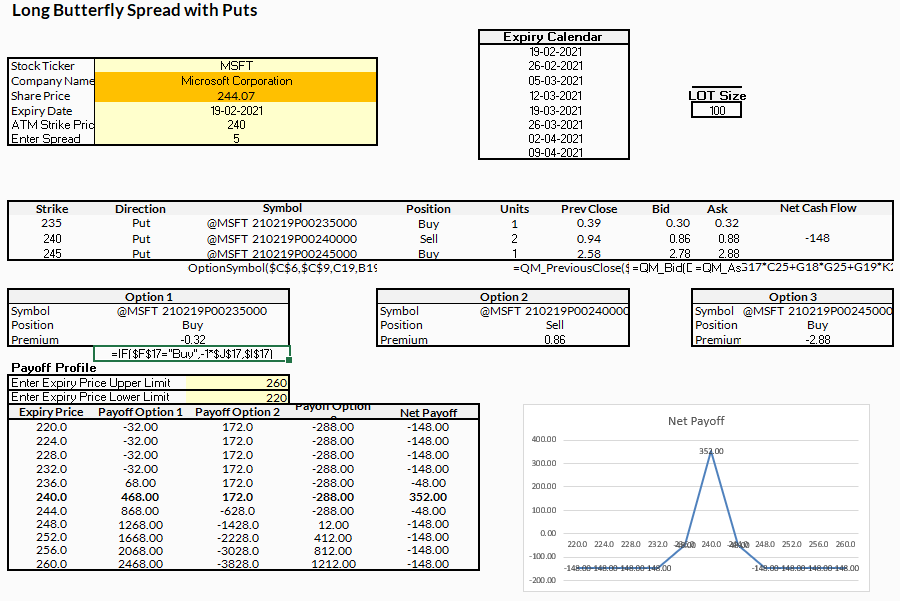 alt="Options Trading (Strategies)">
alt="Options Trading (Strategies)">
A long butterfly option with puts is used when investors are looking for the underlying stock to achieve a specific target price at expiration. This strategy is established for a net debit, and the profit potential and maximum risk are limited.
It consists of two short puts at the middle strike and one long put, each at a lower and a higher strike price. The upper and lower strikes(wings) must be equidistant from the middle strike(body), and all the options must have the same expiration.
Since there are three strike prices and three bid-ask spreads, there are multiple commissions that the trader must pay. It thus becomes essential for the trader to open and close the long butterfly position at reasonable prices to ensure that the risk/reward ratio is favorable.
To learn more about this strategy, read the detailed article here.
The Bottom Line
The bottom line is that one can use options trading to leverage positions and make significant profits. However, they come with risks and require investors to monitor the market constantly. Due to their unique time constraints, they are not for investors who like to set and then forget their investments.
There are two levels of risk when trading options depending upon whether you are the holder or writer of the option. As the option holder, your main risk is losing the entire premium that you paid for the option. If the option expires worthless, then you are out of your entire principal. As the writer of the option, you are exposed to a significantly higher level of risk. If you are writing uncovered calls, for example, then your potential loss is unlimited as the underlying security could potentially rise very high.
Disclaimer
All trademark referenced is the property of their respective owners. Other trademarks and trade names may be used in this document to refer to either the entity claiming the marks and names or their products. MarketXLS disclaims any proprietary interest in trademarks and trade names other than its own, or affiliation with the trademark owner.
None of the content published on marketxls.com constitutes a recommendation that any particular security, portfolio of securities, transaction, or investment strategy is suitable for any specific person. The author is not offering any professional advice of any kind. The reader should consult a professional financial advisor to determine their suitability for any strategies discussed herein. The article is written for helping users collect the required information from various sources deemed to be an authority in their content. The trademarks if any are the property of their owners and no representations are made.
References
Options Trading Strategies: Complete Guide to Getting Started and Making Money with Stock Options – by Scott J. Danes
Using Calendar Trading and Spread Option Strategies. https://www.investopedia.com/articles/optioninvestor/08/calendar-spread-options-strategy.asp
Long Calendar Spread with Calls – Fidelity. https://www.fidelity.com/learning-center/investment-products/options/options-strategy-guide/long-calendar-spread-calls
Get Market data in Excel easy to use formulas
- Real-time Live Streaming Option Prices & Greeks in your Excel
- Historical (intraday) Options data in your Excel
- All US Stocks and Index options are included
- Real-time Option Order Flow
- Real-time prices and data on underlying stocks and indices
- Works on Windows, MAC or even online
- Implement MarketXLS formulas in your Excel sheets and make them come alive
- Save hours of time, streamline your option trading workflows
- Easy to use with formulas and pre-made templates

I invite you to book a demo with me or my team to save time, enhance your investment research, and streamline your workflows.
